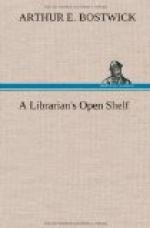To enumerate his degrees, scientific honors, and medals would tire the reader. Among them were the degree of LL.D. from all the foremost universities, the gold medal of the Royal Astronomical Society of London in 1874, the great gold Huygens medal of the University of Leyden, awarded only once in twenty years, in 1878, and the Schubert gold medal of the Imperial Academy of St. Petersburg. The collection of portraits of famous astronomers at the Observatory of Pulkowa contains his picture, painted by order of the Russian Government in 1887. He was, of course, a member of many scientific societies, at home and abroad, and was elected in 1869 to our own National Academy of Sciences, becoming its vice-president in 1883. In 1893 he was chosen one of the eight foreign associates of the Institute of France,—the first native American since Benjamin Franklin to be so chosen. Newcomb’s most famous work as an astronomer,—that which gained him world-wide fame among his brother astronomers,—was, as has been said, too mathematical and technical to appeal to the general public among his countrymen, who have had to take his greatness, in this regard, on trust. They have known him at first hand chiefly as author or editor of popular works such as his “Popular Astronomy” (1877); of his text-books on astronomy, algebra, geometry, trigonometry, and calculus; of his books on political economy, which science he was accustomed to call his “recreation”; and of magazine articles on all sorts of subjects not omitting “psychical research,” which was one of the numerous by-paths into which he strayed. He held at one time the presidency of the American Society for Psychical Research.
The technical nature of his work in mathematical astronomy,—his “profession,” as he called it, in distinction to his “recreations” and minor scientific amusements,—may be seen from the titles of one or two of his papers: “On the Secular Variations and Mutual Relations of the Orbits of the Asteroids” (1860); “Investigation of the Orbit of Neptune, with General Tables of Its Motion” (1867); “Researches on the Motion of the Moon” (1876); and so on. Of this work Professor Newcomb himself says, in his “Reminiscences of an Astronomer” (Boston, 1903), that it all tended toward one result,—the solution of what he calls “the great problem of exact astronomy,” the theoretical explanation of the observed motions of the heavenly bodies.
If the universe consisted of but two bodies,—say, the sun and a planet,—the motion would be simplicity itself; the planet would describe an exact ellipse about the sun, and this orbit would never change in form, size, or position. With the addition of only one more body, the problem at once becomes so much more difficult as to be practically insoluble; indeed, the “problem of the three bodies” has been attacked by astronomers for years without the discovery of any general formula to express the resulting motions. For the actually existing system




